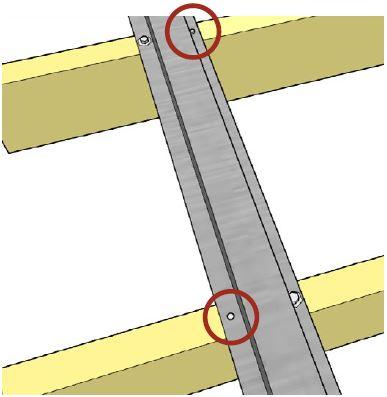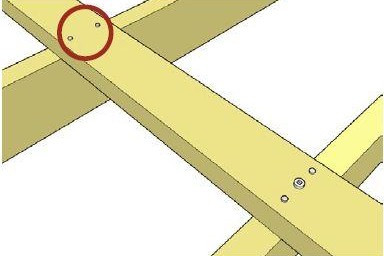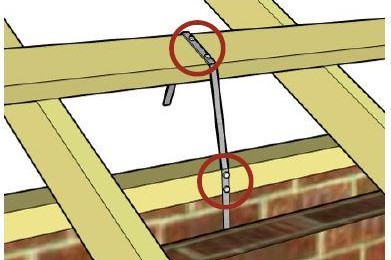This information addresses common construction issues identified through ongoing building audits as well as concerns and queries raised by various stakeholders in the Western Australian building industry.
It also addresses concerns that the current Building Code of Australia and referenced Australian Standards do not have a simple deemed-to-satisfy solution for the WA construction practice of attaching tie-down straps to timber roof/over battens.
To assist with onsite construction compliance, documentation for these elements within the building permit drawings is strongly recommended. This information could include the member size and grade, tie-down position and fixings, and other relevant information referred to in Industry Bulletin 093 – Documentation for timber roof construction.
Diagrams are provided for typical timber wall plates and over-battens used in WA for the purpose of rafter/truss tie-down. A flowchart describing a design methodology for appropriate tie-down of houses with timber-framed roofs is also included. Tie-down battens/wall plates could be sized by a suitably qualified structural engineer to ensure compliance with the applicable building standards. Timber suppliers also have span tables for tie-down battens available online.
The following information has been collated by Building and Energy in collaboration with a recognised expert in timber and wind engineering. It supplements information provided in Australian Standard AS 1684.2: 2010 – Residential timber-framed construction; Part 2: Non‑Cyclonic Areas (AS 1684.2).
Flowchart showing the methodology for appropriate tie-down of houses with timber framed roofs |
Guidance to using tie-down battens/top plates in sheet roofs
Notes:
- Tie-down straps should be installed taut and straight plumb over tie-down battens as shown in Figures 4 and 5.
- Span tables may specify that tie down straps can be installed at any location on the batten/top plate or need to be within a set distance from the rafter.
- Fastening roof sheeting to tie-down battens increases the maximum ULW able to be carried by the tie-down batten.
- Battens are not generally suitable to support construction loads prior to fixing the roof cladding.
- Batten fixings should comply with the tie-down requirements specified in AS 1684.2 (fixings for 45mm deep timber battens should be 1 x 75mm long No. 14 Type 17 screws for N1 and N2 site wind classifications. Longer screws may be required in N3 and N4 sites for some batten and rafter spacings.)
- Batten spacings must also comply with maximum spacing requirements applicable to the roof sheeting manufacturer's product information.
Roof tie-down Q&A
Metal battens
Show moreQ. Where a nailed connection is insufficient for fastening metal battens to timber rafters, can metal battens be fixed with a screw on one side of the batten and a nail on the opposite side, if the position of the screw is alternated between rafters?
A. No. The strength of this connection is the same as the double nailed connection. (The nail would fail first at its normal capacity, and then the batten would be prised over the top of the screw head.) The nail/screw connection does not have higher capacity than a nail/nail connection.
Manufacturers that have carried out an appropriate standard of testing typically recommend two screws for all metal roof battens into softwood timber rafters.
Note: Although the published capacity of some types of nails into JD5 (i.e. MGP10) timber may indicate they have sufficient capacity, until they have been tested in metal battens, they should not be used to fix metal battens.
Timber battens
Show moreQ. Where a nailed connection is insufficient for fixing timber battens to timber rafters or trusses (i.e. metal clad roof), can the timber battens be attached with bugle (No. 14, Type 17 screw) fixings alternated with nail fixings along the length of the battens?
A. No. Nails do not have sufficient capacity so would fail at less than the design wind speed. The batten would not have enough bending capacity to span the distance between the remaining screws.
Nails are not sufficient and will fail causing the standard batten to be overloaded between screwed batten connections.
Nailed connections
Show moreQ. Can machine driven nails be used in metal plate connector brackets (e.g. multigrips, triple grips)?
A. Machine-driven nails in straps or metal plate connectors should only be used if the manufacturers of the straps/ metal connectors recommend them for that situation. In some cases, conditions for use may include installing an extra nail, or only using specially designed connectors for machine driven nails.
Palm nailers can be used to drive connector nails accurately into holes in standard metal plates and straps (similar to hand-driving).
General roofing
Show moreQ. Are lateral restraints required for each end of steel strutting beams?
A. Yes (generally). They are required for timber beams as per Clause 7.2.6 of AS 1684.2 and steel beams have the same tendency to slide or rotate. In many cases, blocking pieces can be fitted to the timber top plate and bolted to the top of the beam to act as lateral restraints.
Q. What should I do if a framing anchor hasn't been nailed correctly? (E.g. nails are too close to the edge of the framing anchor, or timber has split underneath the connection)
A. Most defective connections can be bridged by installing a strap into undamaged timber using the correct number of nails. This should occur in accordance with applicable building standards or under the direction of a suitably qualified engineer.
Q. Can the same tie-down connections be used for standard trusses and girder trusses?
A. No. Girder trusses need stronger tie-downs than standard trusses. Truss suppliers provide tie-down options and guidelines for correct installation.
Q. Do hip rafters need to be tied down at the corners of houses?
A. Yes. Hip rafters need stronger tie-downs than standard rafters as they have larger tributary areas and therefore carry larger loads.
Perimeter tie-downs
Show moreQ. Can roofing be screwed into tie-down battens?
A. Yes. In fact, fixing the roofing to tie-down battens increases their capacity to resist net roof uplift forces. Tie-down battens can be used in the same way as standard battens, but standard battens can't always be used as tie-down battens. For example, metal top hat battens can be used as standard battens, but not as tie-down battens as under uplift forces, the metal batten will crush under the strap.
Q. What tie-downs are required either side of large openings?
A. It depends on the wind classification and the size of the opening. Stronger straps installed into the brickwork at floor level or metal rods into the concrete slab may be required either side of larger openings. There is often insufficient weight of brickwork on top of the lintel to resist the uplift forces by tying to only the lintel.
Q. When fixing a tie-down strap, does it make a difference if the connectors (nails) are fixed to the near face, top face or far face of the timber top plate, rafter, or batten?
A. Yes. The full capacity of the strap requires at least five nails in JD5 (i.e. MGP10 pine) timber. Five nails won’t fit in a single face and the strap must be looped over the timber and the nails distributed between the near face, top face and far face of the timber. Installing at least one nail into the far face of the timber means that the strap is bent twice. The double bend increases the connection capacity (AS 1684.2 gives higher capacities for connections using looped straps).
Q. Where the strap is to be tied to a tie-down batten, can the required number of nails to the tie-down straps be shared between the plate and the tie-down/cavity batten?
A. No. All the nails must be installed into the tie-down batten. (Note that if the tie-down strap is to be fixed to the top plate, framing anchors may be required between rafters and top plates to transfer the uplift forces from the rafter to the top plate as shown in Figure 3.)
This acts as a two-nail connection to either the over-batten or wall plate.
Q. Can perimeter tie-down only be used on any house?
A. Perimeter tie-down only is commonly used in a truss roof and the tie-downs must have sufficient capacity to resist the forces indicated in the truss design. For framed (stick built) roofs, AS 1684.2 allows perimeter tie-down only for coupled roofs in N1 and N2 wind classifications. Engineers can provide details that enable framed roofs to be tied down at the perimeter for houses in N3 and above.





